If you think Iceland is all midnight sun and over-shared waterfalls on Instagram (my opinion), allow me to introduce you to its quieter, icier alter‑ego: Winter.
In winter, the lava fields wear a dusting of snow, the crowds miraculously thin out, and the landscape takes on the kind of stillness usually reserved for high‑end meditation retreats. Selfie attempts are replaced by silence, and the northern winds make sure only the committed hang around long enough to enjoy it (they can be brutal).
This is the season when a campervan truly comes into its own. You’re not shackled to hotel bookings or tour buses. Instead, you decide whether to spend your evening chasing the ever-sought after Aurora Borealis across the tundra or self-marinating in a geothermal pool while snowflakes melt in your hair (and the locals attempt to place you with an overly long stare).
Granted, there are hurdles: icy roads, darkness arriving before your afternoon coffee, and the occasional snow squall that seems to have been scripted by the Norse gods (of snow) themselves. But therein lies the charm.
With a bit of humour, patience, and a reliable heater in your campervan (the earliest plug you’ll ever see in one of my guides), winter in Iceland becomes less a challenge to endure and more an experience to savour.
Chasing the Northern Lights
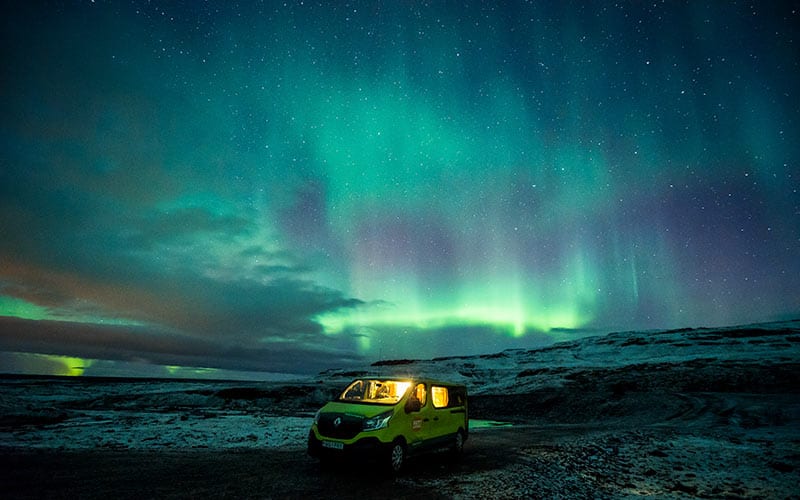
Chasing the Northern Lights in Iceland is less a casual pastime and more a national sport, if you bump into my kind of local outdoorsy oddballs, and for good reason. Few things compare to standing in the biting cold while streaks of green, purple, and pink writhe across the sky in varying levels of intensity (subtle orchestral dances to the “let’s kick the electro beats up a notch”).
Some of our recommended campervan routes to give you the best chances of seeing the Northern Lights allows you to avoid crowded coach tours and stake out your own private vantage points. Some experts swear by Þingvellir, others by the remote Westfjords, but the secret is always the same: go where the skies are clear, and well, hope for the best.
Before you set off, consult SafeTravel and Vedur.is for forecasts, both of which are as vital as each other to maximise your chances of seeing this great wonder, and stay safely on the road.
And here’s where a campervan shines, you can change plans on a whim, chasing breaks in the cloud cover while less mobile travellers sit sulking in hotel lobbies trying tp gaze out past the annoying streetlights of downtown Reykjavík and car lights.
Iceland’s Winter Wonders: Top Activities to Try
While summer may boast endless daylight, winter is when Iceland really goes full beat mode, in my opinon. The snow and ice transform everyday sights into surreal spectacles, and familiar activities suddenly feel extraordinary against this frosty backdrop.
In this section, I’ll take you through some of the experiences that make braving the chill worthwhile. From strapping on crampons to sliding into hot springs, each one should be a reminder that winter in Iceland is anything but dull (also…Christmas!)
Glacier Hiking and Ice Climbing
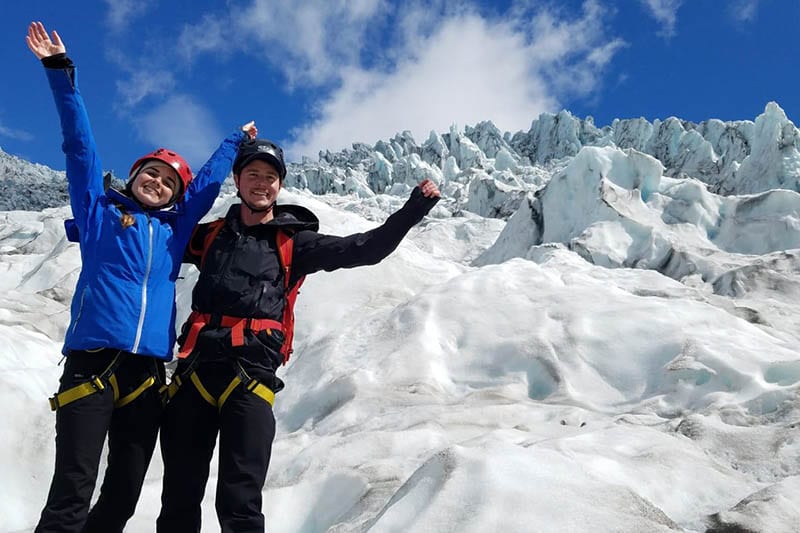
Glacier hiking and ice climbing in Iceland isn’t for the faint‑hearted, but it is the sort of experience that makes your friends’ city breaks look positively dull. Armed with crampons, a helmet, and an ice axe, you’ll tread across surreal landscapes of sapphire‑blue ice, white ice, and even maybe tinged ash ice (from the Eyjafjallajökull eruption in 2010), squeezing into crevasses and standing atop some incredible ridges.
Professional guides tend to keep groups small so you can actually hear yourself think (or panic quietly, depending on your temperament).
Most tours depart from Skaftafell in Vatnajökull National Park, where the glaciers tumble dramatically down from the highlands for hundreds of kilometres along this route. The panoramas alone are enough to silence even the most committed Tiktoker (I believe that is a thing), and the sheer scale of the ice will make you feel like a particularly insignificant extra in a Nordic epic.
If you’re mapping out your campervan route, make sure you add a glacier adventure to the list; it’s an unforgettable story to tell once your fingers have thawed and you can actually message someone about it. Experience. Defrost. Repeat (classic).
Exploring Crystal Ice Caves
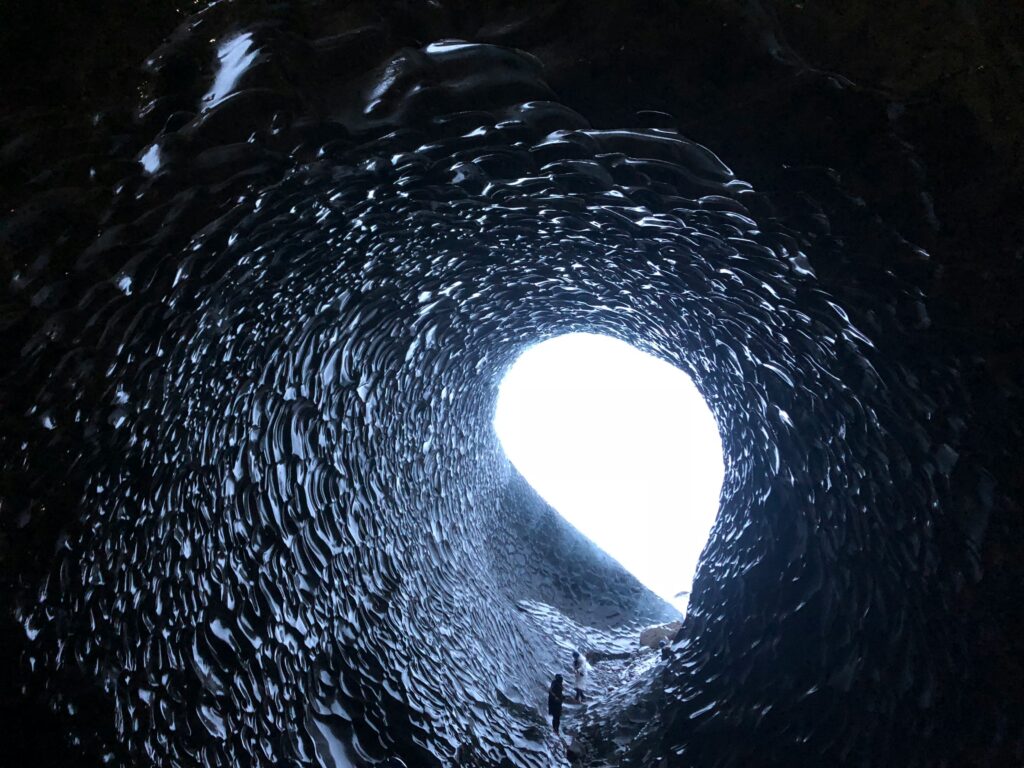
Crazy ice caves are Iceland’s seasonal showpieces. They’re commonly vast, translucent chambers carved out of glacial ice that shimmer seemingly impossible shades of blue.
Step inside one near Vatnajökull and you’ll feel as though you’ve wandered into a frozen cathedral, complete with natural skylights where the winter sun pierces through. The silence is broken only by the occasional drip of meltwater, (or in some years, inner ice cave waterfalls) reminding you this wonder is very much alive and constantly changing. And for the science abstainers among you, glaciers are constantly moving. So each year we get new pockets of air that create ice caves, making no two caves, or even visits, ever the same.
Access to these caves is limited solely to the winter months; by spring, they can collapse or flood, erasing themselves from the map until nature decides to rebuild (sometimes with a little help from some locals).
Tours book up quickly, so reserving a spot is essential. Visiting an ice cave is a one‑season performance hosted graciously by Iceland’s glaciers, miss them now, and you’ll have to wait another year for the curtain to rise again (ice to thaw and move – experience, defrost, repeat, after all).
Snowmobiling on Glaciers
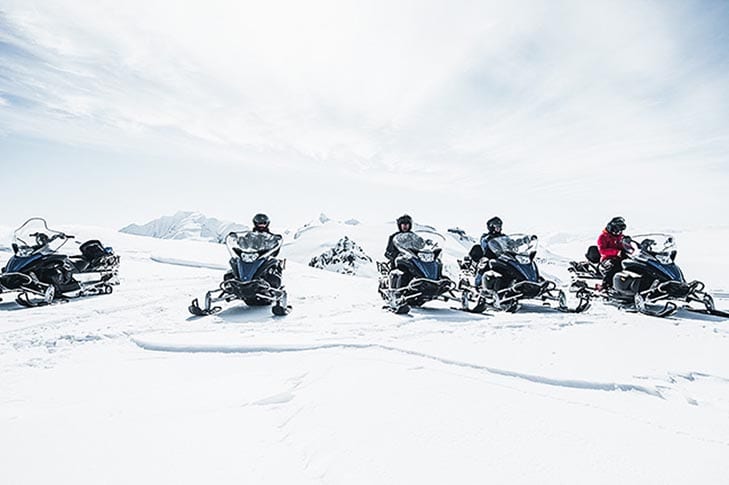
Snowmobiling on Iceland’s glaciers is less about subtle sightseeing and more about strapping yourself to a roaring machine and tearing across a landscape that may or may not be streaking across one of Earth’s largest volcanic calderas.
You’ll skim over miles of untouched snow with nothing but endless white horizons and the occasional glacial crevasse for company. For the adventurous, it’s a surreal way to experience the country’s frozen wilderness, which is equal parts exhilaration and absurdity.
Many tours run on Langjökull, Iceland’s second‑largest glacier, where the sheer scale of the icefield makes you feel very small and very lucky to be alive (and you can tick off Gullfoss waterfall just before you head off into the white tundra).
Skiing and Snowboarding in the North
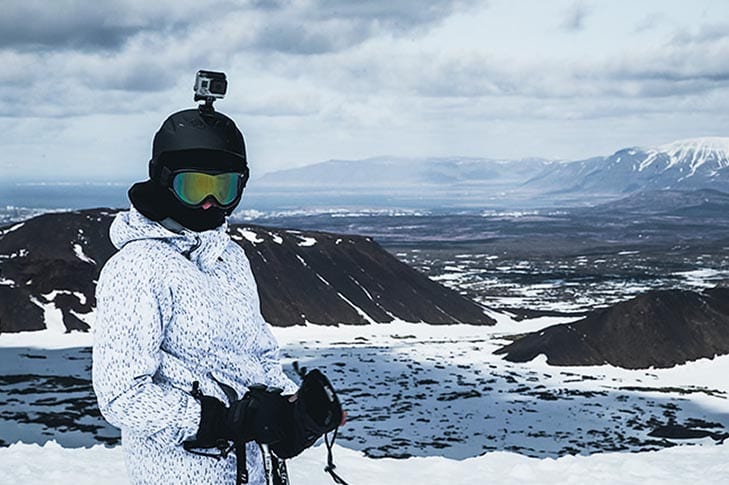
The ski scene in Iceland is modest but surprisingly rewarding, offering a unique flavour of winter sport that feels distinctly Nordic. Resorts such as Hlíðarfjall in Akureyri or the slopes around Siglufjörður provide a handful of runs that are blissfully free of the queues and jostling you might endure in the Alps.
You won’t find chic après‑ski clubs (and by this I mean loud David Guetta tracks with crowds chugging a bottle of Jaggermeister), glitzy boutiques, or overpriced fondue restaurants. What you will find are wide‑open pistes, crisp mountain air, and views of snow‑laden fjords that more than compensate for the absence of Champagne bars.
For beginners, the slopes are basically friendly and unintimidating, with instructors happy to ease you in. For more experienced skiers and snowboarders, the novelty of carving turns practically at the Arctic Circle is reason enough to clip in. Add to that the chance of spotting the Northern Lights after a day on the slopes, and you have a ski trip like nowhere else on earth (ahem, try the Vínbúðins if you now fancy a Jagermeister).
Whale Watching in Winter
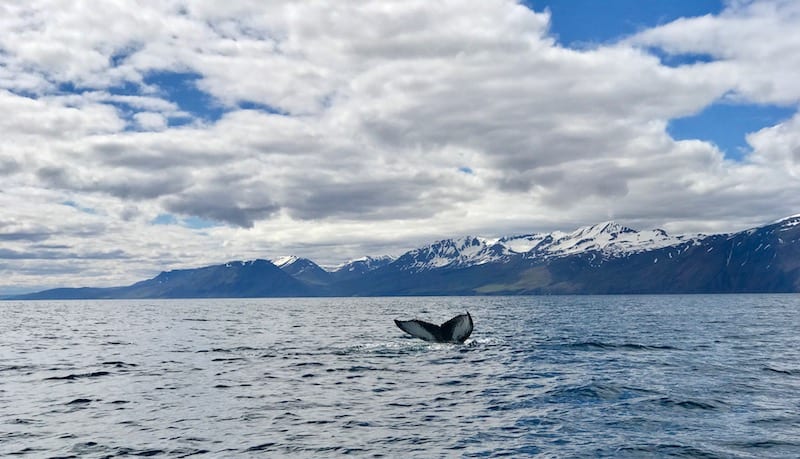
Winter whale watching may sound counterintuitive, but Iceland’s waters remain astonishingly full of life even when the air is bracing and the daylight scarce. Pods of orcas are frequently spotted around Grundarfjörður in the Snæfellsnes region (near Kirkjufell mountain which Game of Thrones fans will enjoy), especially in January and February when they follow the herring into the fjords.
Humpback whales, too, can often be seen in northern bays, their great tails lifting out of the water against a backdrop of snow‑draped mountains is pretty damn awesome. The best part is that the summer crowds are gone, leaving you with uninterrupted views and far fewer elbows jostling for the perfect photograph (again, apologies for my mother).
Dress warmly, keep binoculars at hand, and prepare to be both dwarfed and delighted by creatures that seem utterly unfazed by life in icy seas. Maybe work on your David Attenborough impression in advance, also.
Hot Springs and Geothermal Baths
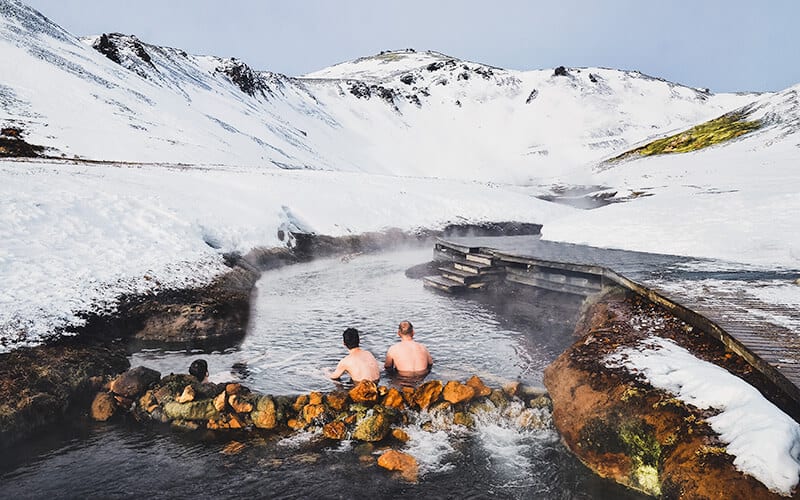
There are few pleasures greater than lowering yourself into a 40 °C pool while your hair freezes into comical spikes above the waterline. Iceland’s hot springs and geothermal baths are open year‑round, but winter lends them a special magic that summer simply can’t match. The contrast between the freezing air and the steaming water can feel quite theatrical, as if you’ve slipped into a secret ritual performed only for the hardy (cold pool dips would be even hardier).
The famous Blue Lagoon may be the most photographed, but it’s far from the only option. Smaller gems like Laugarvatn Fontana, the Secret Lagoon in Flúðir, or even natural hot spings hidden in the countryside provide a quieter, more authentic soak.
With a campervan, you can turn hot spring hopping into a personal itinerary, stringing them together into a geothermal tasting menu. You can stop, soak, steam, repeat, until you’re happily pruned and utterly content. Ask our team for some extra tips when you pick up your camper.
Horse Riding in the Snow
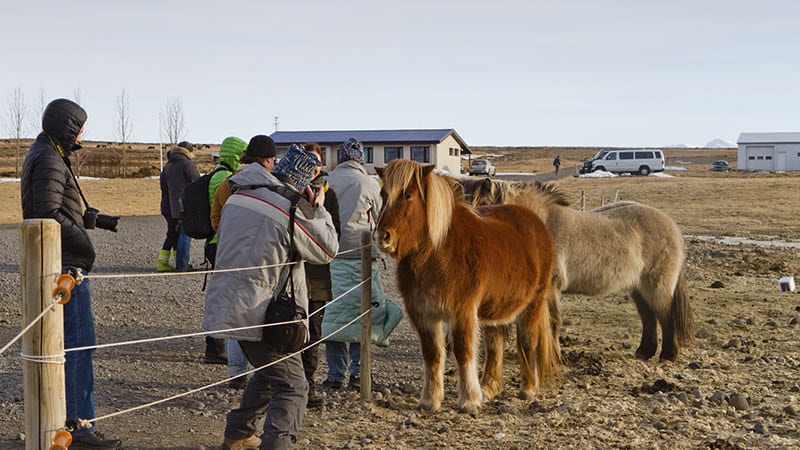
Icelandic horses are practically made for winter, and they know it. Stocky, furry, and endlessly good‑natured, they trot through snow with an elegance that borders on smugness, their thick coats shrugging off wind and frost as if the elements were a minor inconvenience.
These frost-bearing creatures have been bred for centuries to handle precisely this sort of weather, and riding one through a snowy landscape feels less like a tourist activity and more like stepping into the rhythm of Icelandic life.
Taking a ride in the wintry countryside introduces you to their unique tölt gait, which is smooth, steady, and astonishingly comfortable, while you pass frost‑covered lava fields and mountain backdrops (am I selling it yet?)
It’s less about speed or adrenaline and more about feeling connected to an animal that has served as a steadfast partner to Icelanders since the first settlers arrived. In that sense, a winter horse ride is both a cultural experience and a whimsical adventure rolled into one. You don’t even have to stray far from Reykjavík to try it out.
Dog Sledding and Reindeer Spotting
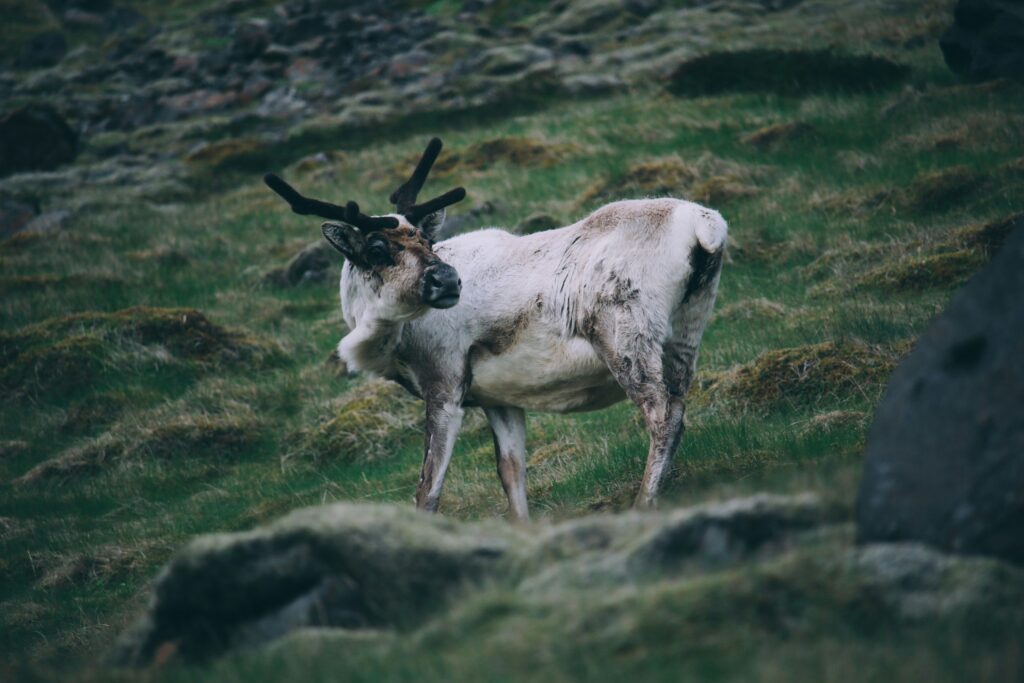
Dog sledding in Iceland may not be as synonymous with the country as in Greenland or Alaska, but it delivers every bit of the thrill. Try to imagien a team of eager huskies straining against their harnesses, with excited barks echoing across the snowy plain before they leap into motion, pulling you into a scene that feels part Arctic expedition, part joyous chaos.
The ride is fast, exhilarating, and unforgettable, leaving you grinning long after the dogs have been unhitched and rewarded with well‑deserved cuddles, and of course, doggy treats.
In East Iceland, the adventure occasionally comes with a bonus. We call the bonuses ‘reindeer’. These animals, descendants of a herd introduced in the 18th century, now roam wild across the region.
Spotting a group of antlers cresting a ridge against the snow is like stumbling into a living Christmas card. You can see them as far west as Jökulsárlón Glacier Lagoon if you’re lucky, but otherwise, head into the East (I swear that is not an intentional Tolkien quote).
Road Trips and Scenic Routes in Winter
Driving around Iceland in winter is less a straightforward journey and more an ongoing negotiation with the weather gods. Roads can be dazzlingly clear one hour and buried under snowdrifts the next, but that unpredictability is part of the charm.
For those willing to embrace the occasional delay, and armed with a campervan that doubles as a warm refuge, the rewards are spectacular. In this section, I’ll uncover the best winter-friendly routes where dramatic landscapes and roadside wonders make every kilometre worth the effort (now you know to bookmark this guide for inspiration when you’re tired and grumpy in Iceland).
Ring Road in Winter: Myths and Truths
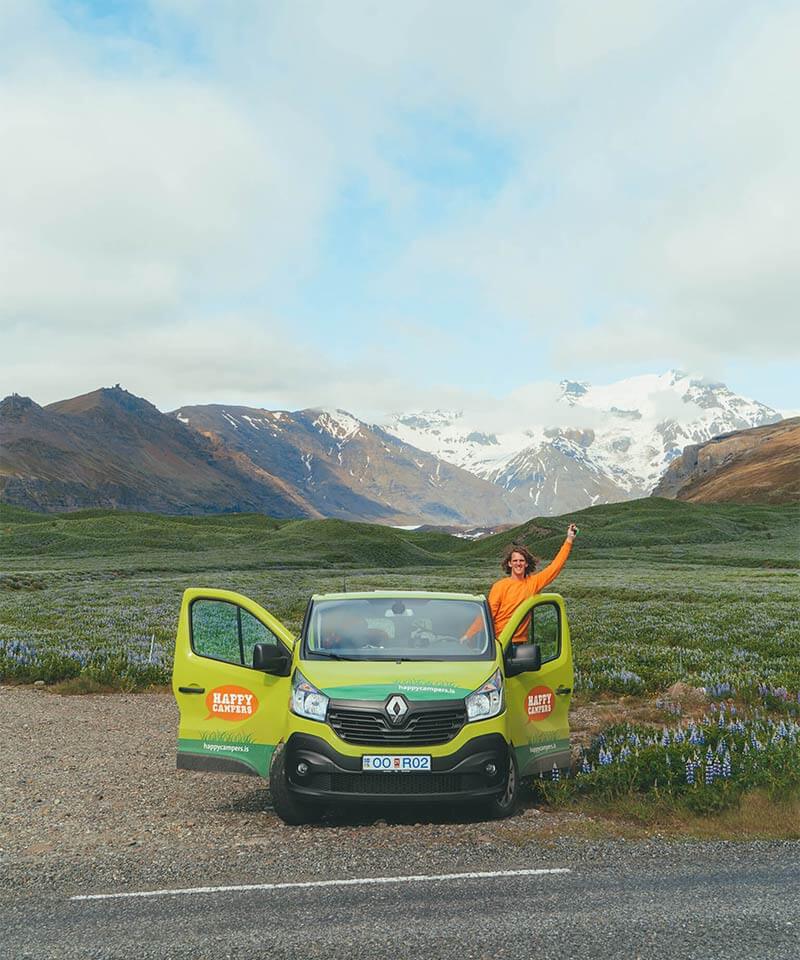
The fabled Ring Road doesn’t close entirely in winter, but it does require patience and caution.
Some stretches, particularly in the east, can be quite impassable during storms. That said, with a 4×4 campervan and a sensible approach, large sections remain accessible. The journey should be considered less as a guaranteed circumnavigation and more as a flexible journey.
When the weather behaves, you’ll cover miles; when it doesn’t, you’ll discover the joy of slowing down. And by ‘discover’, I mean you’ll be forced to.
The Golden Circle in the Snow
The Golden Circle is an Iceland classic, and it doesn’t skip a beat in winter. Gullfoss thunders through ice, half‑frozen and desperately clinging to all sides of the canyon. The mighty Strokkur geysir bursts defiantly from beneath the snow almost to prove that geothermal energy laughs in the face of frost (it is it’s kryptonite, after all). Þingvellir meanwhile gleams under a frosty coat, its tectonic rift made even more dramatic against a white canvas.
Because the route is short, well‑maintained, and close to Reykjavík, it’s ideal for those attempting their first winter campervan expedition from the city. If you’re a campervan newbie, this will be your crash course in Icelandic rural exploration, filled with waterfalls, a geyser (that has already singed Ed Sheeran’s feet), and national history all within a single day.
Wrap up in your layers, and enjoy Iceland’s most iconic attractions with a fraction of the summer crowds and a good deal more atmosphere.
South Coast Adventures
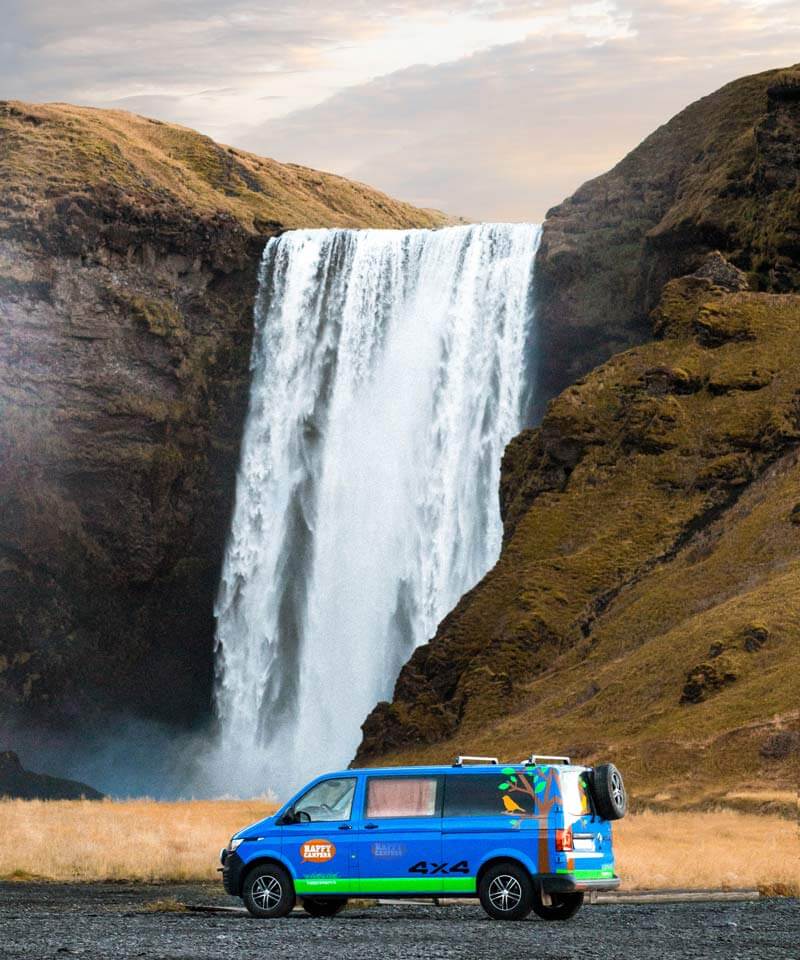
The South Coast is a corridor of wonderful spots that never fails to impress, whatever the season.
In winter, waterfalls like Seljalandsfoss and Skógafoss freeze into jagged chandeliers, their spray crystallising into delicate icicles that hang like decorations on nature’s own Christmas tree.
Black‑sand beaches, such as the famous Reynisfjara, become even more epic when dusted with snow (please be careful of the sleeper waves). Meanwhile, mighty glaciers such as Sólheimajökull creep almost to the roadside, reminding you that in Iceland, the ice is never far away (and this one is caked in the dark charcoaled ash from the famous 2010 eruption I mentioned earlier).
Jökulsárlón Glacier Lagoon is particularly haunting during the darker months, where eerie blue icebergs glow in twilight as seals bob lazily among them, as well as the much rarer occasional walrus.
Across the road you’ll find the Diamond Beach, where chunks of ice wash ashore and sparkle like jewels against volcanic sand, and seem to tempt some older vessels as a resting spot (don’t linger on the ice).
Northern Iceland in Winter
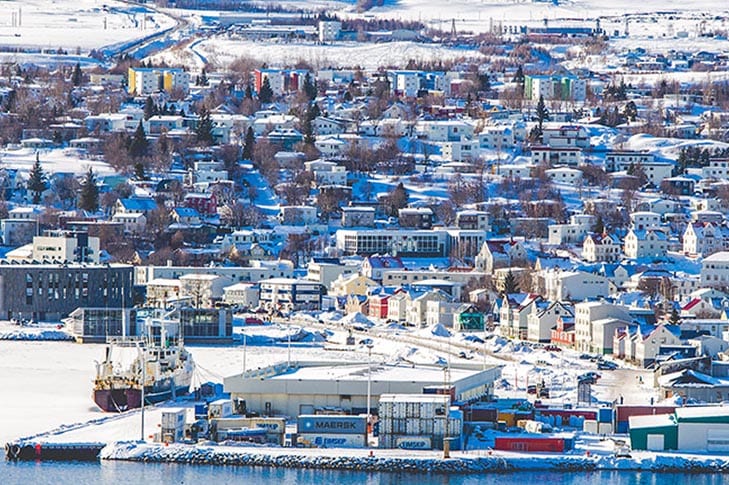
Heading north rewards you with Akureyri, the so‑called (self-proclaimed) “capital of the north”, where ski slopes, steaming hot tubs, quirky cafés, and a lively town centre give it the feel of a small city determined to punch above its weight (especially in terms of obscure art galleries and hidden restaurants).
It’s also a convenient base for exploringthe famous fjords of the Nort. In winter, snow blankets the surrounding mountains, making the town and surrounding area a hub for skiing, snowshoeing, and post‑adventure hot chocolate (or maybe some Irish Hot Chocolate).
Further east lies Iceland’s answer to the Great Lakes, Mývatn, a geothermal wonderland where bubbling mud pools and steaming vents keep the landscape theatrically alive, even in the depths of winter.
The Mývatn Nature Baths provide a soothing soak without the crowds of the Blue Lagoon, offering panoramic views across frozen fields while you sit blissfully warm in mineral‑rich water (in short: it’s pretty awesome).
Combined, Akureyri and Mývatn showcase the quieter, less touristy side of Iceland that rewards those willing to venture a little further from Reykjavík. And if you want to add in Whale Watching in Húsavík and the mighty Dettifoss waterfall, then you my friend, have accidentally completed the Diamond Circle (congrats!)
The Icelandic Highlands: Should You Even Try?
In a word: no. The Highlands are not merely off‑limits in winter, they are effectively a frozen wilderness laboratory, beautiful but entirely unforgiving.
Snow buries the tracks, rivers freeze over, and storms sweep in without warning, cutting off even the most experienced drivers (rulebreakers). Attempting to venture there is not bold or pioneering, it is reckless to the point of absurdity, making it a voyage not even Dennis Quad would consider doing (and he was willing to risk his life for Jake Gyllenhaal).
Save the Highlands for summer when the roads reopen and you can actually enjoy the stark beauty and adventure without risking life and limb. In winter, concentrate your campervan adventures on the coasts, where the scenery is every bit as stirring and accessible without the danger of becoming a headline on RÚV (Icelandic BBC News, basically).
Essential Tips for Winter Travel in Iceland
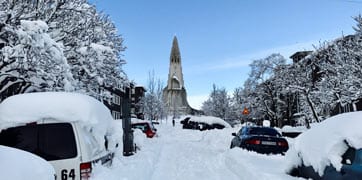
Travelling through Iceland in winter isn’t simply a matter of throwing on a woolly hat and hoping for the best (though I admit, this is often the best self-description I can think of). The season is beautiful, yes, but it also demands a little forethought if you’d rather not star in your own survival documentary.
From the scarcity of daylight to the unpredictability of storms, visitors need to come prepared with both the right gear and the right mindset. So, let me help you discover the ultimate Arctic road trip while avoiding the pitfalls that less‑prepared travellers inevitably stumble into (usually anyone who comes off the plane in fli flops).
Weather, Daylight, and Safety
Daylight is a scarce commodity in midwinter, sometimes shrinking to a mere four hours. So you must plan your activities carefully and embrace the long nights as part of the adventure.
Safety should always trump ambition; storms blow in quickly, and conditions can shift within minutes. But fear not, our winter travel guide (written by yours truly) covers everything from weather apps to emergency numbers. Trust me, I’ve done winter before.
Driving a Campervan in Snow and Ice
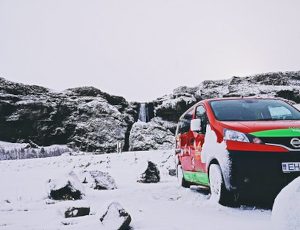 Processed with VSCO with inf preset
Processed with VSCO with inf preset
We outfit all of our campervans with studded tyres, efficient heating, and support systems to make winter driving as stress‑free as possible. You’ll also find extras like snow brushes, ice scrapers, and emergency gear, small things that make a big difference when the weather suddenly remembers it indeed is the real protagonist of your travels.
A 4×4 may be necessary in certain regions, and knowing when to opt for one can mean the difference between a smooth adventure and a very expensive rescue story. The golden rule is simple: if the road looks dicey or the forecasts frown at you, pull over, brew a hot drink in your camper’s kitchenette, and wait it out. Iceland isn’t going anywhere, and neither should you until it’s safe (put this in your list of great things ‘Chris Says’).
Packing Smart for the Arctic Chill
Dress like an onion: layers are everything. Thermal underwear, waterproof outerwear, gloves, and a sturdy hat are essential.
Bring crampons for slippery paths, and yes, pack swimwear. You’ll thank yourself when you’re floating in hot springs or taking in a dip in one of the many local swimming pools while snowflakes land on your nose.
Using SafeTravel and Forecasts
Bookmark SafeTravel, Vedur.is, and Road.is to keep track of storms and closures. Treat these resources as gospel. But, when in doubt, if locals aren’t driving, you probably shouldn’t either (and some of the locals can at times seem completely weather ambivalent).
Why a Campervan Is the Best Way to Explore Iceland in Winter
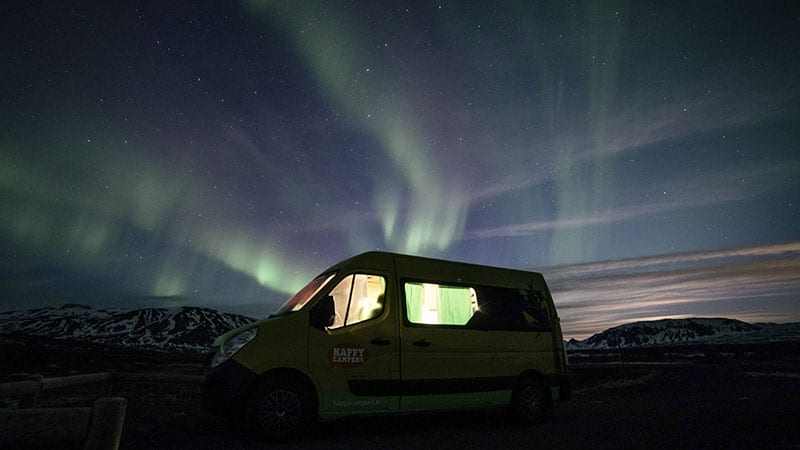
At first glance, winter in Iceland might seem like the sort of environment where only the hardiest locals or a passing polar bear would thrive. Yet with the right set of wheels (preferably one that doubles as a warm little cabin, if you catch my drift) you unlock an entirely different experience.
Campervans give you independence in a country where the weather laughs at itineraries, where the Northern Lights refuse to follow human timetables, and where remote hot springs lure you in with the belief that they are ‘just off the beaten track’. They are not simply a practical choice but the difference between watching Iceland from behind hotel curtains and truly living in it.
Freedom to Chase Clear Skies
Auroras are gloriously unreliable, appearing when they please and vanishing just as abruptly.
The beauty of travelling by campervan is that you don’t have to sit still and hope. You can follow clear‑sky forecasts, veer off your original route at a whim, and position yourself miles from the tour‑bus crowds (believe me you won’t want to linger near all their annoying torchlights and stumbling over your tripod when you just framed the perfect shot).
This freedom dramatically improves your odds of catching the aurora in all its shimmering, multicoloured splendour, turning what might have been a missed opportunity into the highlight of your trip.
Warmth, Comfort, and Flexibility
Your campervan is your rolling base camp, equal parts shelter, kitchen, and hotel room with ever‑changing views. Heating systems keep you snug while outside the wind might unwelcomingly howl, a compact kitchen lets you whip up a midnight feast after Northern Lights hunting, and a comfortable bed means you can sleep wherever (but remember you need to sleep at a campsite, it’s the law).
One night you might spend a great deal of stargazing right next to a frozen waterfall (I recommend Þórufoss for this), the next at the edge of a lava field with nothing but silence and stars for company. It’s a far cry from the rigid schedule of hotels and tour groups, and it transforms the way you experience the country.
Waking Up to Frozen Waterfalls
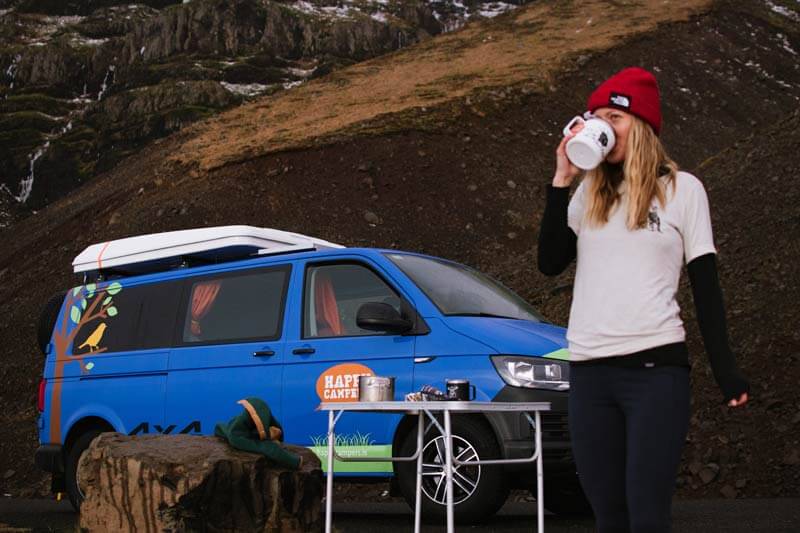
The romance of campervan travel is magnified in winter, when every morning carries the potential for something truly cinematic. Pull back the curtain and you might be greeted by Skógafoss, half‑frozen and sparkling in the weak morning sun, or perhaps by a nameless cascade tumbling over icy cliffs with no one else around to see it (a treat for the early bird oddballs amongst you – I know you’re there!)
Other mornings reveal fjords painted in soft pastel light or supposedly dormant volacanoes capped with snow like enormous meringues. These are the sorts of moments that make frost on your eyelashes, numb fingers fumbling with the kettle, and the occasional icy dash to the toilet block feel like a minor toll for front‑row seats at one of nature’s finest performances.
Final Thoughts: Make Winter Your Playground in Iceland
Winter in Iceland is not an ordeal, it’s an invitation. The country reshapes itself into a playground of ice caves, auroras, steaming hot springs, and snow‑bound adventures. Yes, it requires resilience, but the reward is an experience that feels private, profound, and unforgettable. With a campervan as your companion, you hold the keys to Iceland at its most magical, so go and enjoy Mr Potter.
Back